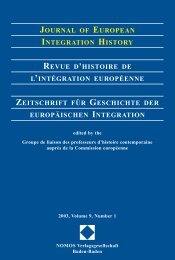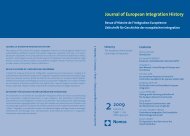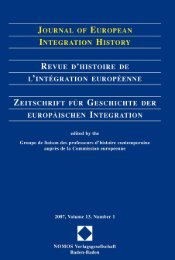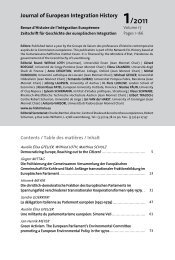journal of european integration history revue d'histoire de l ...
journal of european integration history revue d'histoire de l ...
journal of european integration history revue d'histoire de l ...
You also want an ePaper? Increase the reach of your titles
YUMPU automatically turns print PDFs into web optimized ePapers that Google loves.
58<br />
Tapani Paavonen<br />
selainen announced, at a meeting <strong>of</strong> Nordic Prime Ministers and Nordic Cooperation<br />
Ministers in July 1959, Finland's readiness to join the planned Nordic customs<br />
union, the Finnish government had already <strong>de</strong>ci<strong>de</strong>d in principle in favour <strong>of</strong> the<br />
Seven. Finland's <strong>integration</strong> aim, as expressed by the Prime Minister, consisted <strong>of</strong><br />
an exclusively economic agreement, which would not inclu<strong>de</strong> any supranational<br />
<strong>de</strong>cision-making pr<strong>of</strong>ile and which should safeguard Finland's extensive bilateral<br />
tra<strong>de</strong> with the Soviet Union.<br />
The British government regar<strong>de</strong>d it as politically purposeful to inclu<strong>de</strong> Finland<br />
in the sphere <strong>of</strong> the emerging EFTA, and the Nordic governments acted on the basis<br />
<strong>of</strong> mutual Nordic solidarity. Thus, when Finland's aspiration was repeated later in<br />
the same July 1959, at a ministerial meeting <strong>of</strong> the Seven, by Ahti Karjalainen, the<br />
Finnish Minister <strong>of</strong> Tra<strong>de</strong> and Industry who in fact led the Finnish negotiations<br />
process un<strong>de</strong>r Presi<strong>de</strong>nt Kekkonen, it was agreed upon that the Finnish government<br />
was allowed to follow the proceeding negotiations. However, on the <strong>de</strong>mand <strong>of</strong> the<br />
British, Finland's observer was not allowed to be present in the negotiation room<br />
but was to be kept informed, in the first place, through Swe<strong>de</strong>n.<br />
The Soviet Union opposed Finland’s EFTA membership. Apparently, the Soviet<br />
lea<strong>de</strong>rship was nonetheless ready to accept alternative arrangements for free tra<strong>de</strong> between<br />
Finland and the EFTA countries, which in the first place would have meant bilateral<br />
agreements between Finland and the individual EFTA countries. The Finns when<br />
preparing a policy position in 1959 took into consi<strong>de</strong>ration such bilateral agreements<br />
but this procedure was found unfeasible, alone because the GATT provisions would<br />
have obliged Finland to generalise tra<strong>de</strong> preferences to all the Contracting Parties. The<br />
only way was either to join EFTA according to Article 41 Paragraph 1 <strong>of</strong> the Stockholm<br />
Convention or to create an association according to Paragraph 2 <strong>of</strong> the same article.<br />
Presi<strong>de</strong>nt Kekkonen, seemingly, committed himself already at the early stages <strong>of</strong> Finland's<br />
moves towards EFTA to satisfy the Soviet <strong>de</strong>mand <strong>of</strong> non-membership, even<br />
though the exact content <strong>of</strong> such a commitment remained unclear. Nor were the Soviet<br />
objections known among wi<strong>de</strong>r circles.<br />
Finland's negotiation position, <strong>de</strong>fined in early 1960, envisaged either joining or<br />
creating an association with EFTA. In any case, the Finnish <strong>integration</strong> aim was <strong>de</strong>fined<br />
as follows:<br />
“The competitive position <strong>of</strong> Finnish exports will be safeguar<strong>de</strong>d in such a way that<br />
[1] The domestic market industries will be guaranteed appropriate tariff protection<br />
for a transitional period<br />
[2] The special position <strong>of</strong> agriculture will be preserved<br />
[3] Finland's present significant commercial relations with third countries, especially<br />
with countries outsi<strong>de</strong> GATT with which Finland has a bilateral commercial agreement<br />
on a most favoured nation treatment, will not be endangered”. 5<br />
Negotiations were carried out from February to May 1960, after the Stockholm<br />
Convention had been signed. Finland's <strong>de</strong>licate international position was reflected<br />
5. Records <strong>of</strong> the Finnish Foreign Ministry (FM Records) 58 DA: Foreign Tra<strong>de</strong> Committee (Kauppapoliittinen<br />
neuvottelukunta) 4 January 1960, “Suomen suhteet EFTA: an”.

















